The AMD Llano Notebook Review: Competing in the Mobile Market
by Jarred Walton & Anand Lal Shimpi on June 14, 2011 12:01 AM ESTFusion GPU Takes on Gaming
For our gaming tests, we’ll start with our Low and Medium detail gaming benchmarks. We’ll save Asymmetrical CrossFire and High detail gaming for the next page. Note that we run all of the Low and Medium tests using DX9/DX10 modes, even on games that support DX11. There reason is simple: in nearly every game with DX11 support, enabling it often proves too taxing for anything but the fastest discrete GPUs—or in other cases, the graphics quality difference is negligible (Civilization V, Metro 2033, and Total War: Shogun 2 fall into this category). When we refresh our list of games later this year, we might start testing DX11 more often, but for now we’ll stick with DX9/10 on mainstream laptop testing.
Low Detail Gaming
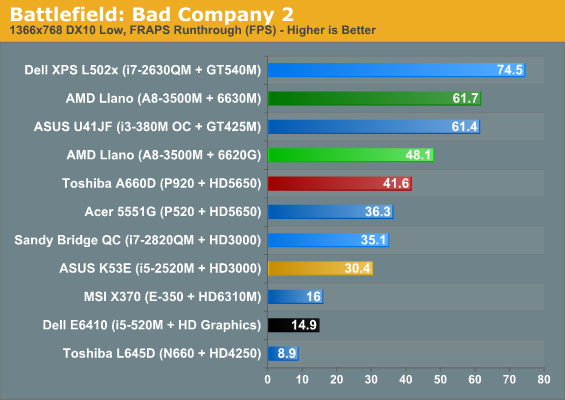
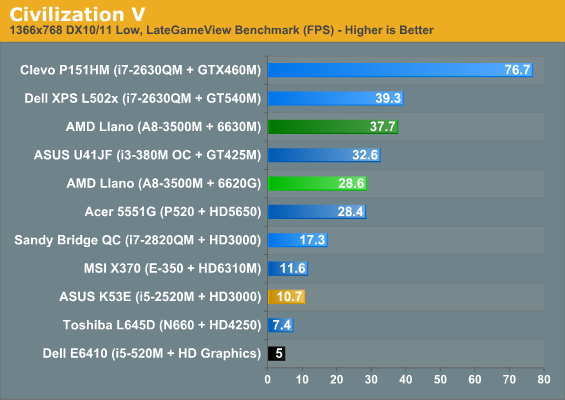

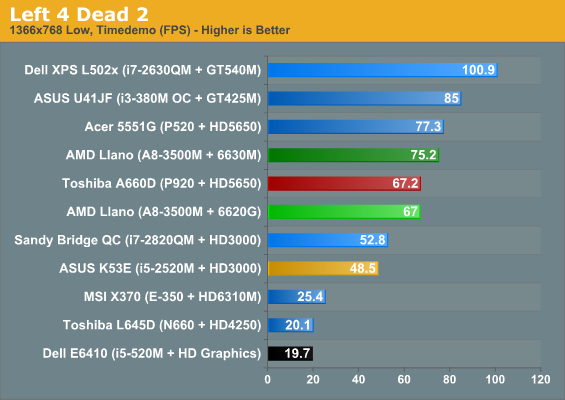
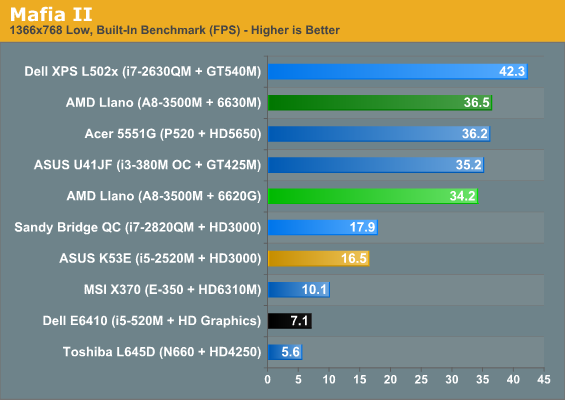

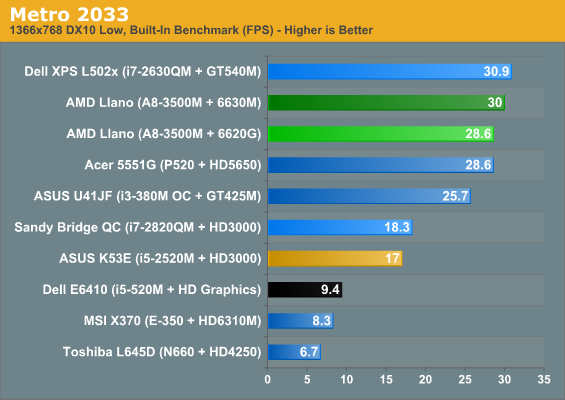
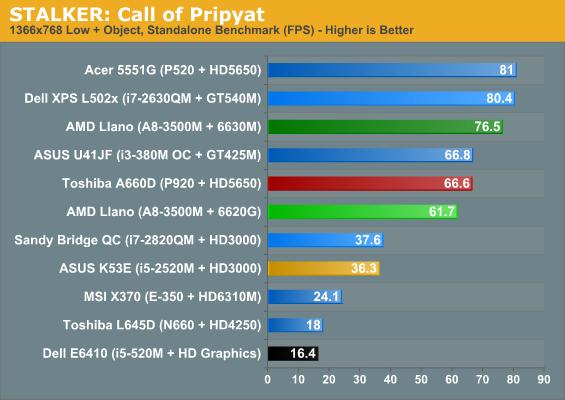
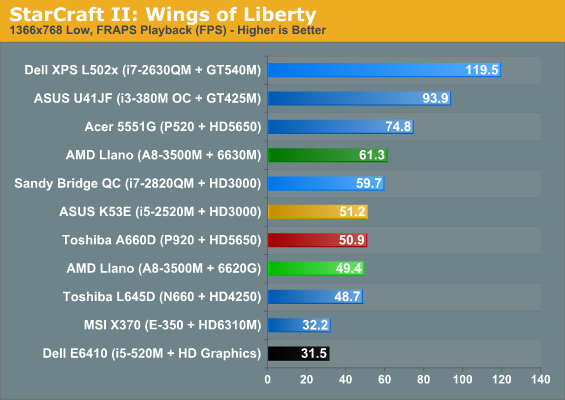
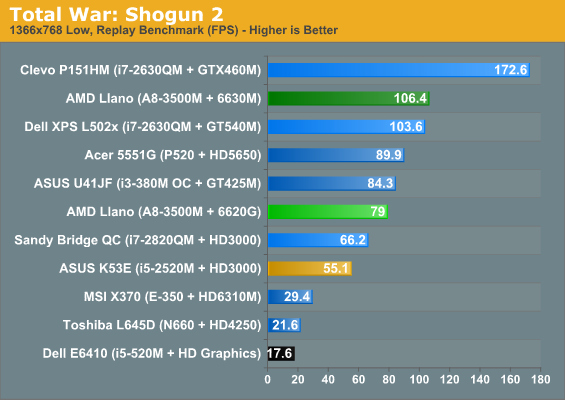
Medium Detail Gaming
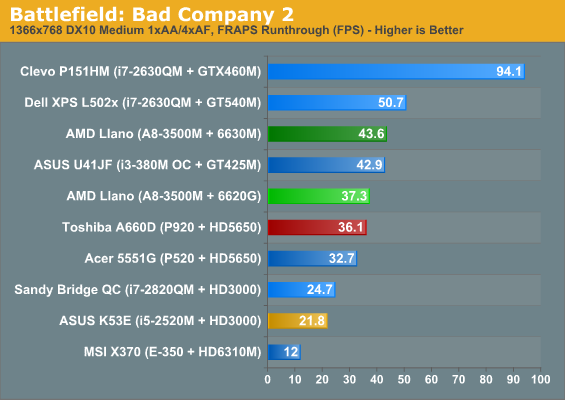
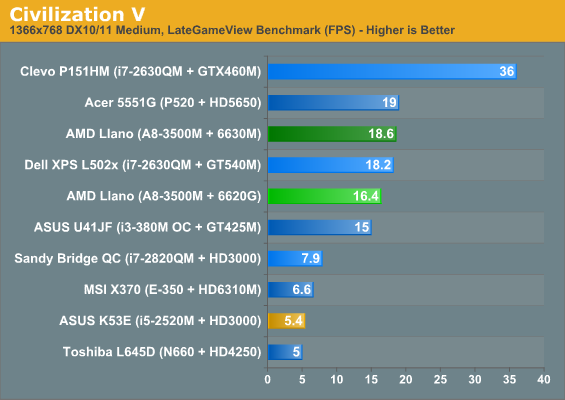
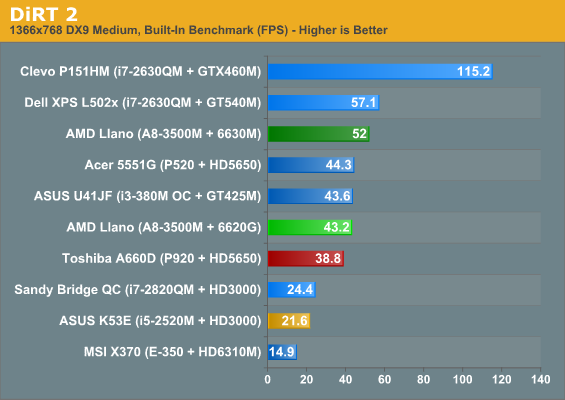
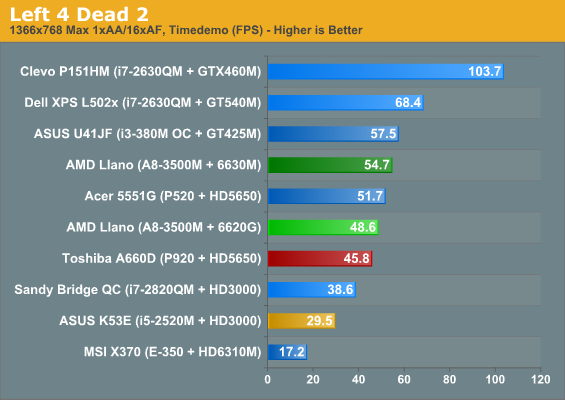

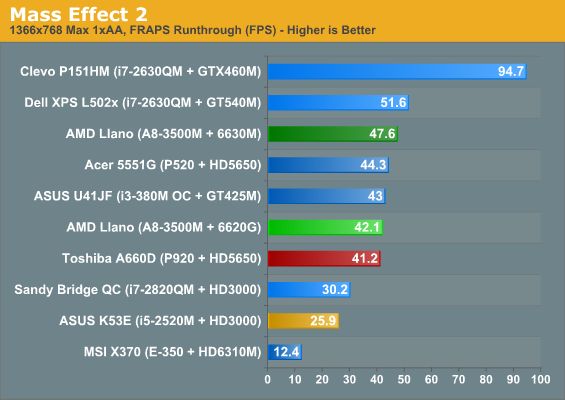
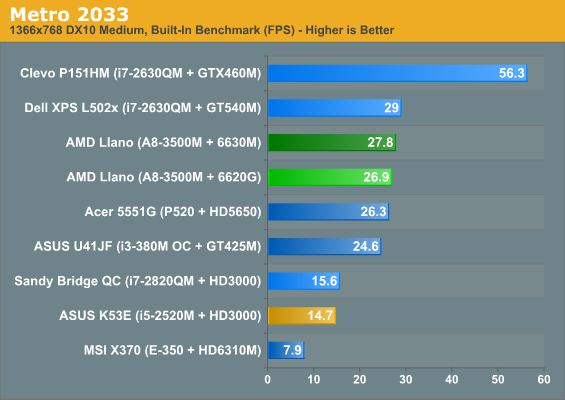
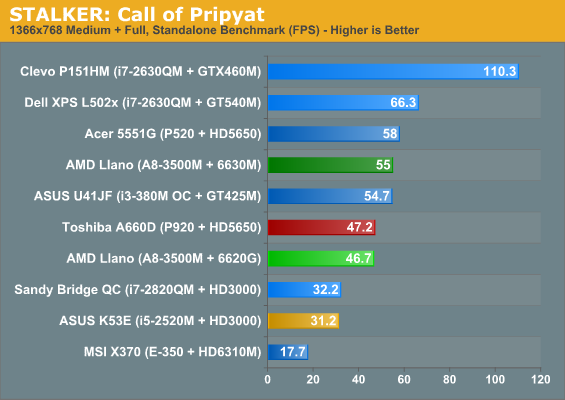
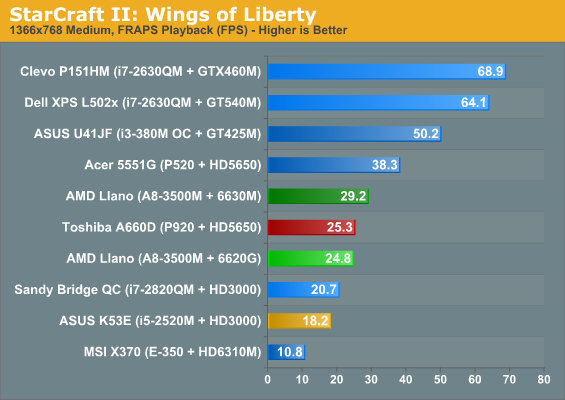
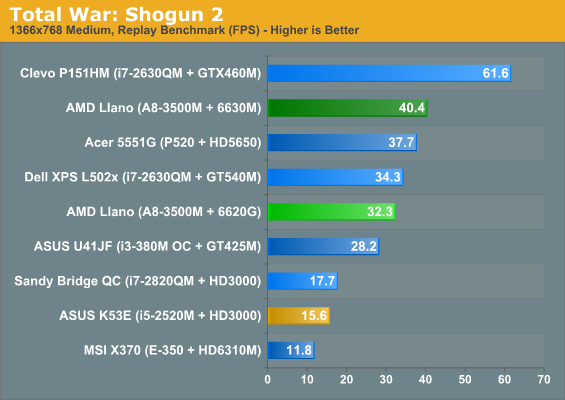
The age-old adage is that if you want a good gaming experience, you need to put more money into the graphics subsystem. With Llano, we need to modify that and add a corollary that you can trade a faster CPU for a better IGP/fGPU and end up with acceptable gaming performance. The 6620G is the first integrated GPU that can actually keep pace with the midrange discrete GPUs (at least on laptops—desktop GPUs are a different story). The Llano A8-3500M comes out ahead of AMD’s previous P920 + HD 5650 in many of the results, while A8-3500M + HD 6630M adds anywhere from 3-40% and averages 24% faster than the 6620G.
If we look at the competition, A8-3500M is anywhere from -3.5% to 167% faster than Intel’s HD 3000 with dual-core SNB, running everything at our Low presets. The sole victory for Intel comes in the lightly-threaded StarCraft II where Intel can really flex its Turbo Boost muscles. On the other end of the spectrum, HD 3000 turns in extremely poor results in Civilization V, Mafia II, and Metro 2033—games where Llano is at least playable. On average, the A8-3500M is 50% faster than HD 3000 at Low settings; move up to our Medium settings and Llano is 76% faster on average, with leads in every title ranging from 36% (StarCraft II is again the worst showing for AMD) to as much as 204% (Civilization V).
Bring the older Arrandale into the picture and things get even more lopsided. Never mind the fact that Arrandale’s HD Graphics are unable to break 30FPS in most of our test games at minimum detail (StarCraft II being the one exception); at our Low presets, A8-3500M puts Arrandale to shame, with performance anywhere from 57 to 472 percent faster and 223% faster on average. Obviously, you don’t want to try gaming on Arrandale’s IGP, which is where laptops like the ASUS U41JF come into play. You can pick up the U41JF for just over $800, but while the CPU is certainly faster, gaming performance with the GT 425M is only 15% faster than the stock A8-3500M on average, with Llano pulling wins in Civ5, Metro 2033, and TWS2 at Medium detail.
As a final note on gaming performance, while the A8-3500M isn’t clocked particularly high, there’s still more performance on tap in many games. Switching over to the 6630M dGPU improves performance by an average of 20% over the fGPU. A few titles only show an incremental performance increase (Metro 2033 and Mafia II); the biggest performance gains come in DiRT 2 and Total War: Shogun 2, with performance increases of 40%/35% respectively at low detail and 20%/25% at medium detail.
The target price of $700 for A8 laptops could make for a reasonably powerful and inexpensive gaming laptop, and if it’s like current AMD notebooks I suspect we’ll see A8 laptop prices dip into the low $600s. $800 for A8 Llano with the 6630M becomes a more difficult proposition, considering it would butt up squarely against laptops like the U41JF. Gaming performance would be similar, but the larger battery would give ASUS (and Intel) the lead in that area and gaming performance would be largely a wash. Depending on how much of a threat Intel deems Llano to be, we could see SNB laptops similar to the U41JF push pricing down, but for now Llano certainly fills a popular market niche.










177 Comments
View All Comments
ET - Tuesday, June 14, 2011 - link
So, what do you tell them? The only benchmarks of The Sims 3 I could find are pretty old and didn't offer much detail, but I think based on them that high quality would require more than the lowest IGP. (Then again, normal or low quality should probably run fine on anything.)msroadkill612 - Tuesday, August 2, 2011 - link
ta 4 the post - but dont salesmen have a duty to sell them a bit of insurance against the next game fadash9 - Tuesday, June 14, 2011 - link
Bring on the OpenCL apps, excuse me applications- Excel rewritten to take advantage of heterogeneous computing would silence everyone about Star CPU cores. The ball is in the hands of the people (to buy them), then the software developers (to program for them) - that's why Star cores? APU apps neededmsroadkill612 - Tuesday, August 2, 2011 - link
I think it will happen. Big mobs will identify niches that can profit from OGPL & profit from using it - open languages always win in the end.I see fusion server apuS in the future.
FISHRULE - Tuesday, June 14, 2011 - link
What a terrible CPU, who would want something that performs like a Phenom in a new computer circa 2011. The future might be fusion AMD, but you sure as heck aren't part of the future anymore.jabber - Tuesday, June 14, 2011 - link
90% of laptop owners wouldnt know if they were using a Brazos or an i5 in their laptops.The only real differential is in transcoding, ripping etc. and very few folks in the real world actually do that. Especially on laptops.
Price is far more important than outright performance. Has been for some time now.
RussianSensation - Tuesday, June 14, 2011 - link
False. My gf doesn't know anything about computers. But she somehow knew that Intel makes the best mobile CPUs even before asking me what to get. Clearly Intel marketing > AMD's. All of my current friends who just bought a computer all went with i3/i5/i7 processors only because they "heard" Sandy Bridge is the fastest CPU around.Llano is nothing more than a Phenom with a faster GPU. Phenom already didn't sell well against C2D/C2Q/Core i7 (1st) gen and isn't getting any better against SB. The only way AMD is gaining market share is if they ship cheap laptops with Llano to users for whom the price of a laptop is the most important factor.
ET - Tuesday, June 14, 2011 - link
Well, you have pretty computer literate friends. Most people I know would have no idea what Sandy Bridge is, probably not even what i3 and i5 are, and would only buy i3 or i5 because: a) AMD had very little market presence until now; b) I'd recommend them. That said, most of the people I know have no idea that AMD exists and is making CPU's (I mention it occasionally, and they're always surprised, so I guess it doesn't register), so it does look like AMD's marketing is pretty crappy.That said, I think that your analysis of why Llano will fail isn't right. For most people the CPU power really doesn't matter that much. They'd have no idea if i3 or Llano is better, and most likely won't be able to tell the difference in practice (unless they run a game for which the HD 3000 is unsuited). Sure Llano is for the low end market, but that's where most sales are, and it's certainly much improved in terms of power usage, which is an important enough measure to help it gain market share.
RussianSensation - Tuesday, June 14, 2011 - link
You are probably right that most people won't tell the difference between a Llano or an i3/i5/i7. But to them the perception of knowing that they have a slower CPU is what matters. One of my friends was building a PC for browsing the net only. I told him he'd be perfectly fine with a $100 CPU but he insisted that the system must have Sandy Bridge because it's the latest modern CPU. I gave up trying to convince him that his internet browsing experience will be more limited by his ISP latency and speed rather than CPU performance.So as long as AMD convinces the average consumer that Llano is at at least as good, they will do well. The problem is AMD's marketing department is worse than a 1st year undergrad student studying marketing in business school. They think if they pay millions of dollars to put AMD on F1 cars, people will notice?
You made a very important point - a lot of people don't even know what AMD is or that there is another competitor to Intel. Imagine if GM, Ford or Chrysler made cars that were more reliable than Honda or Toyota. It would still be a while until the average consumer would abandon the Japanese brands since the perception of reliability would lag behind reality. AMD has this similar problem with their CPU brands, which only marketing can fix.
jrs77 - Tuesday, June 14, 2011 - link
Really... that's rather unimpressive.The GPU of Llano beats intels HD-graphics in games, what a surprise. But how many people do I know personally, that play games on their laptops anyways? Laptops are primarily used as mobile office-computers and they do still rely more on CPU-performance.
From all the experience I've made the HD3000 graphics of mobile SNB CPUs are perfectly fine for all tasks I throw at them (excluding games). So the question is, why would I buy a Llano-based laptop instead of a SandyBridge one?
Llano doesn't offer better battery-life so the only reason might be the price, but with i5-2xxx laptops starting at $600 I really don't see alot of competition there for intel, if we're talking anything else then gaming.